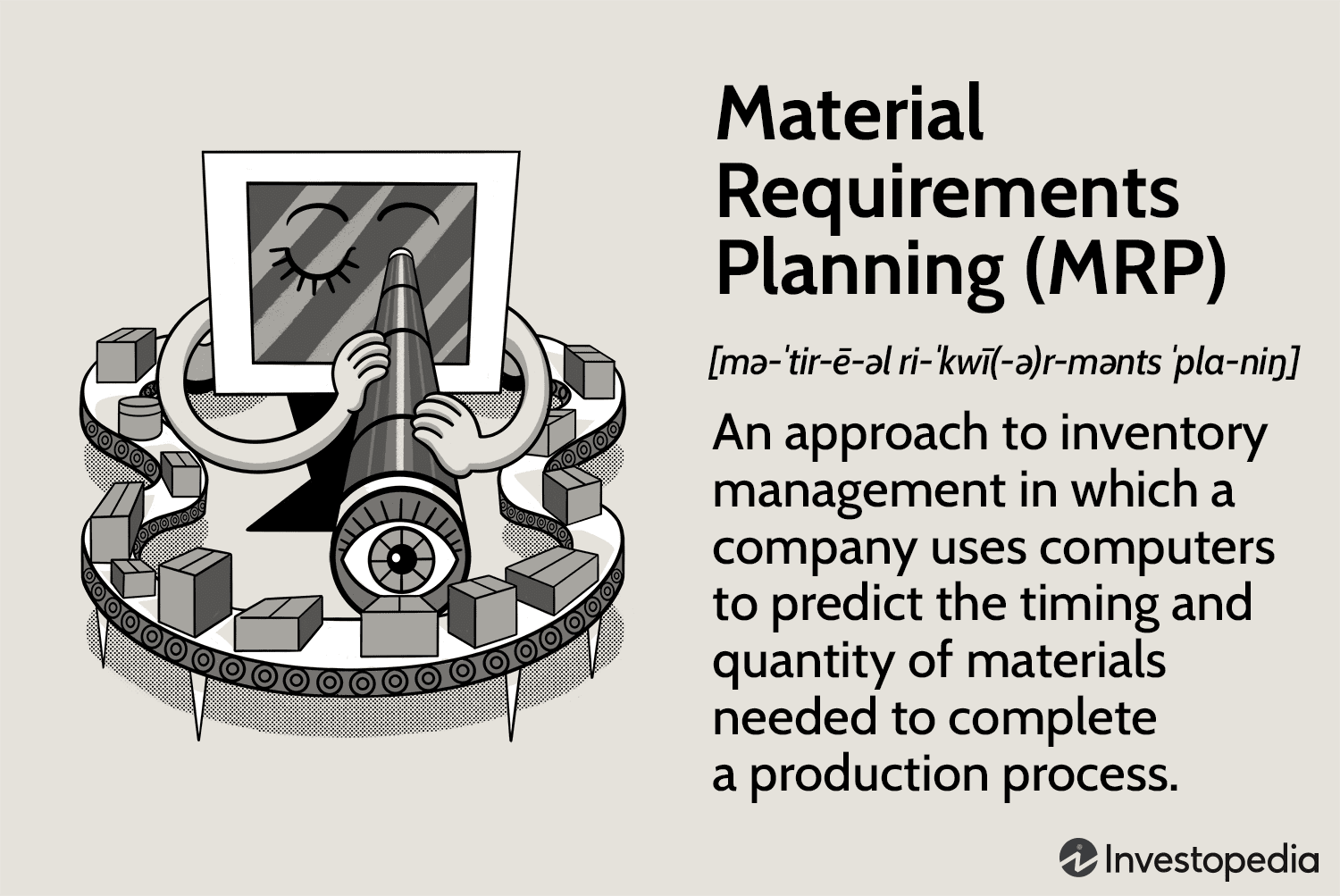What Is Material Requirements Planning (MRP)?
Material requirements planning (MRP) is a software-based integrated inventory and supply management system designed for businesses. Companies use MRP to estimate quantities of raw materials, maintain inventory levels, and schedule production and deliveries.
KEY TAKEAWAYS
- Material requirements planning (MRP) is the earliest computer-based inventory management system.
- MRP helps develop a production plan for finished goods by defining inventory requirements for components and raw materials.
- MRP assures that materials and components will be available when needed, minimizes inventory levels, reduces customer lead times, and improves customer satisfaction.
- MRP relies on data accuracy, has a high cost to implement, and maintains a strict production schedule.
How Material Requirements Planning (MRP) Works
MRP helps businesses and manufacturers define what is needed, how much is needed, and when materials are needed and works backward from a production plan for finished goods.
MRP converts a plan into a list of requirements for the subassemblies, parts, and raw materials needed to produce a final product within the established schedule. MRP helps manufacturers get a grasp of inventory requirements while balancing both supply and demand.
Using MRP, managers can determine their need for labor and supplies and improve their production efficiency by inputting data into the MRP scheme such as:
- Item Name or Nomenclature: The finished good title, sometimes called Level “0” on BOM.
- Master Production Schedule (MPS): How much is required to meet demand? When is it needed?
- Shelf life of stored materials.
- Inventory Status File (ISF): Materials available that are in stock and materials on order from suppliers.
- Bills of materials (BOM): Details of materials and components required to make each product.
- Planning data: Restraints and directions like routing, labor and machine standards, quality and testing standards, and lot sizing techniques.
MRP and Manufacturing
Manufacturers manage the types and quantities of materials they purchase strategically and cost-effectively to ensure that they can meet current and future customer demand. MRP helps companies maintain appropriate levels of inventory so that manufacturers can better align their production with rising and falling demand.
BOM
A bill of materials (BOM) is an extensive list of raw materials, components, and assemblies required to construct, manufacture or repair a product or service.
The MRP process:
• Estimates demand and required materials. After determining customer demand and utilizing the bill of materials, MRP breaks down demand into specific raw materials and components.
• Allocates Inventory of materials. MRP allocates inventory into the exact areas as needed.
• Schedules Production. Time and labor requirements are calculated to complete manufacturing and a timeline is created.
• Monitors the process. automatically alerts managers of any delays and even suggests contingency plans to meet build deadlines.
History of MRP
Material requirements planning was the earliest of the integrated information technology (IT) systems that aimed to improve productivity for businesses by using computers and software technology.
The first systems of inventory management evolved in the 1940s and 1950s, using mainframe computers to extrapolate information from a bill of materials for a specific finished product into a production and purchasing plan. MRP systems expanded to include information feedback loops so that production managers could change and update the system inputs as needed.
The next generation of manufacturing resources planning (MRP II), also incorporated marketing, finance, accounting, engineering, and human resources aspects into the planning process. A concept that expands on MRP is enterprise resources planning (ERP), developed in the 1990s, which uses computer technology to link various functional areas across an entire business enterprise.
Advantages and Disadvantages
Pros
- Materials and components are available when needed
- Minimized inventory levels and associated costs
- Reduced customer lead times
- Increased manufacturing efficiency
- Increased labor productivity
Cons
- Heavy reliance on input data accuracy
- Expensive to implement
- Lack of flexibility in the production schedule
- Tendency to hold more inventory than needed
- Less capable than an overall ERP system
MRP vs. ERP
Enterprise resource planning (ERP) is an extension of MRP systems. While MRP is a planning and control system for the resources in a company, ERP is a solution for the enterprise as a whole and an ERP system includes advanced functionality in the areas of financial, customer relationships, and sales order management.
Material Requirement Planning can be a stand-alone application or a piece of an ERP, a single solution that addresses all business needs, not just the scheduling of resources. It decreases any information redundancies and adds elements, like user-level security.
Benefits of an ERP system include increased efficiency, integrated information, customized reports, and higher-quality customer service,
What Are the 3 Main Inputs?
The three basic inputs of an MRP system include the Master Production Schedule (MPS), Inventory Status File (ISF), and Bill of Materials (BOM).
How Does it Benefit a Business?
MRP ensures that materials and components are available when they’re needed, inventory levels are optimized, manufacturing efficiency is improved, and customer satisfaction increases.
What Are the Outputs of an MRP System?
Using required inputs, the MRP calculates what materials are needed, how much is needed to complete a build, and exactly when materials are needed in the build process.
This allows businesses to use just-in-time (JIT) production, scheduling production based on material availability. This minimizes inventory levels and businesses can move materials through the manufacturing process efficiently.
The Bottom Line
Material requirements planning is a software-based integrated inventory and supply management system that companies use to estimate quantities of raw materials and schedule production. By inputting information like the Master Production Schedule, Inventory Status File, and the Bill of Materials (BOM), Material Requirement Planning calculates the materials needed, how much are needed, and when they are needed in the manufacturing process.
SPONSORED
Finding the right financial advisor that fits your needs doesn’t have to be hard. Smart Asset’s free tool matches you with fiduciary financial advisors in your area in 5 minutes. Each advisor has been vetted by Smart Asset and is legally bound to act in your best interests. If you’re ready to be matched with local advisors that will help you achieve your financial goals, get started now.
Article Provided By: Investopedia

TSVMap is here to help grow manufacturing processes and consult your IT Solutions that way we can make it more effective and efficient. So if you need: IT Solutions, Consultants, ERP Systems, MRP Systems, Automations, or Cyber Security. Contact us today at 864-991-5656 or Email info@tsvmap.com









0 Comments